From the minutes of the Constitutional Convention for the Philippines, January 24, 1935.
Category: Colonialism
Lo Sheng preservation in doubt
The historic Lo Sheng Sanitarium, built by the Japanese colonial government in 1930 and located in Sinjhuang City, Taipei County, may not be preserved after all. As I wrote about following my visit there this summer, activists have been working to arrange a preservation agreement for the site with the government, following a plan to demolish it entirely to make room for a metro train depot. The government had made a promise to preserve 40 (approximately 3/4) of the buildingds on the site, but now appears to be reneging.
The protest came after the Taipei County Government posted a bulletin on Tuesday in which it said that residents who have not moved out before Monday would be evicted, including residents living in 25 buildings the government had promised to preserve.
[…]
The government agreed to preserve 22 buildings at the first site.“Of the 40 buildings that were to be preserved, the Department of Rapid Transport Systems only guarantees the safety of 15 during construction. It will fence the other 25 buildings, which means residents cannot live there anymore,” the group said in a statement.
[…]
They said the government’s sincerity in vowing to preserve the sanatorium was doubtful.“The preservation agreement was made last May, but until now, the government hasn’t declared the sanatorium a historical site … Before it is declared as a historical site, we will not allow the MRT department to destroy the complex,” the group said.
(From Taipei Times)
An uncannily accurate prediction
I just finished reading the book Sketches From Formosa, a memoir by the English Presbytarian missionary Rev. W. Campbell, D.D., F.R.G.S., Member of the Japan Society in 1915. This is one of many wonderful facsimile reprint editions of old books concerning Taiwanese history (in both English and Japanese) published by the Taiwanese historical publisher Southern Materials (南天), which I picked up in their Taipei store. Towards the end of the book he gives his impressions of the Japanese takeover of Taiwan and their policies, and in that section (p. 325-6) was the following passage concerning Japanese efforts to eliminate opium use in Taiwan:
Those who favoured the gradual method of extinction felt that there were serious objections to an immediate adoption of the root-and-branch way of going to work. For example, they said-as many Medical Missionaries have also affirmed-that the latter course would entail unspeakable misery on the opium-smokers themselves, and that the enactment of stringent laws in such circumstances would necessitate a fleet of armed cruisers round the Island to prevent smuggling, with Police establishments and Prison accomodation on a scale which simply could not be hoped for.
Doesn’t this sound like a pretty good description of our current failed drug war policies, from a 1915 perspective?
Losheng photos finally uploaded
I have finally uploaded a photo gallery to accompany the article I posted on my visit to the LoSheng leper colony in Taipei. It has been appended to the original post, but I’ll embed here as well. I recommend viewing them in fullscreen mode, and titles may optionally be turned on.
Wushe, then and now
The Taipei Times reported today that Taiwanese film director Wei Te-sheng (魏德勝) is currently attempting to make a film about the famous Wushe Incident of 1930, in which the aboriginal people of Wushe village rose up in armed rebellion against the Japanese occupiers, killing well over 100 Japanese (and injuring many more) before themselves being slaughtered in retaliation. What I found particularly interesting about the article, aside from the fact that I would very much like to see the film if it is ever made, is that the inhabitants of Wushe are described throughout as “Seediq“.
The Sedeq are an Aboriginal tribe that live mostly in Nantou and Hualien counties.
The film title, Seediq Bale, means “the real person” in their language.
The movie Seediq Bale tells the story of Sedeq warrior Mona Rudao who led a large-scale uprising against the Japanese in present-day Wushe (霧社) in Nantou County.
On the morning of Oct. 27, 1930, Mona led a group of more than 300 Sedeq and launched a surprise attack as the Japanese gathered to participate in a local sports event, killing 125 and wounding 215.
The Sedeq then cut the telephone lines and occupied Wushe for three days, before retreating to their strongholds deep in the mountains.
The Japanese colonial government cracked down on the Sedeq, using more than 2,000 military and police officers, and even used poisonous gas banned by international law.
After being under siege for months, Mona, along with about 300 other Sedeq warriors, killed himself.
The Seediq are one of the smallest, if not the smallest, officially recognized distinct tribe of aboriginal peoples in Taiwan, and before receiving government recognition in April of this year had been considered to be a sub-grouping of the much larger Atayal tribe. During my trip to Taiwan last month, I spent about a week traveling with a classmate at Kyoto University named Yayuc Panay, a member of the Seediq tribe who was back in Taiwan visiting family and doing some field research for a paper she is writing. In between visiting two different aboriginal villages, we actually stopped briefly in Wushe for her to transfer her legal residence (戶口) from her hometown of Puli, where her family no longer lives, to her sister’s house in another part of Nantou County. While she was in the office, I wandered around the tiny area comprising Wushe’s “downtown” and took some photos.
Despite being known almost exclusively for the Seediq uprising of 1930, Wushe is today a small village primarily inhabited by Taiwanese of Han Chinese origin, who settled there due to its convenient location as a trading post for the various agricultural goods produced in the mountains. As you can see in the photos, it looks very much like the main street of other rural Taiwanese communities.
Children of Darkness
On Saturday, I went with a friend of mine to see the “Children of the Dark“(闇の子供たち) , a new film by Japanese director Sakamoto Junji primarily about child prostitution in Thailand. The story is primarily told through the perspective of the two Japanese main characters, a reporter for Bangkok bureau of the fictional Japan Times (no relation to the actual English language Japan times, but more of a pastiche of the Asahi or Mainichi. I believe the Mainichi was thanked in the credits) named Nambu, and a Japanese college student named Keiko, who is volunteering at a tiny Bangkok NGO. Secondary characters include Nambu’s mildly irritating 20-something Japanese backpacker/photographer sidekick, and a wide selection of Thai criminals, NGO workers, and abused children.
Except for a brief trip back to Japan around the middle of the film, it takes place entirely in Bangkok. The dialogue is mixed Thai and Japanese, probably with Thai dominating. Nambu speaks appropriately good Thai, as a foreign correspondent should (even if they don’t all), and Keiko speaks a bit haltingly, but according to the subtitles at least she seems to have no trouble expressing complex thoughts, or understanding what anyone says.
The central plot thread is your fairly typical “newsman uncovers a story and chases it ragged even at the risk of his own life” and makes sure to include a selection of the typical cliches, such as a back-alley gunpoint menacing in which none of the stars are harmed, despite a secondary Thai character having been shot in the head in another scene moments before or the photographer’s constant wavering between going home to safety in Japan or staying in Thailand to fight the good fight. At the beginning of the film, Nambu receives a tip that Thai children are being murdered so their organs can be transplanted into dying Japanese children. This is just one of the ways in which children become disposable in the film, but I felt like the addition of this imaginery (although certainly not impossible) scenario to the array of real horror detracted from the film’s effectiveness.
The primary goal of the film is the depiction of evils inflicted by adults on children, and there are a number of truly unpleasant scenes involving child prostitution by foreigners of both Western (American and European) and Japanese origin, as well horrendous mistreatment of the child slaves by their Thai captors. These sorts of terrible things happen all day long in many parts of the world, and it is understandable that the film makers wanted to depict it on screen, but I found the “deeper” messages to be more muddled than sophisticated.
Incidentally, the Japanese Wikipedia article on the film has a rather odd criticism I’d like to mention briefly. It mentions that Japanese blogs (2ch-kei foremost I imagine) have called it “an anti-Japanese film” since it “puts all of the blame for the selling of children in Thailand on the Japanese.” This claim is patently absurd. Of course a significant part of the film’s purpose IS to blame Japan predatory Japanese, but Western perverts are given at least as much of a spotlight in the brothel vignettes. And the Thai criminals who actually run the victimization business are hardly made out to be innocent bystanders.
For some reason I was mildly irritated by Keiko’s inexplicably competent Thai throughout the film, but it may simply have been the fact that I found the character generally pointless. When she first arrives at the NGO, one of the ladies working there asks her “Why did you come to Bangkok, isn’t there some good you can do in Japan?” While this question lingers throughout the film, and naturally Keiko does come to do some good in Bangkok, her motivations are never explored and her character acquires no depth. Why did she come to Thailand? Why is she even in this movie? She is tabula rasa- a standin for the audience, or rather for the way the film maker wants the audience to think. Her initial appearance suggested that she could have been an aspect of a message that I think the filmmakers were trying to convey-that Thailand (and presumably other countries like it, although no others are mentioned) are playgrounds for Japanese and Western neo-colonialists to act out their fantasies of either depravity or heroism without repercussion. However, despite this theme perhaps being touched on ever so briefly during her first appearance, Keiko turns out to be nothing but an autonomic cliche of a young NGO volunteer.
I hope my ramblings do not give the impression that I hated the movie- I did not. I would, in fact, say that it was overall decent. But I did find it very disappointing. It starts well, and has a number of powerful scenes of horror and despair, but it is too long, the story is meandering and a bit cliched, and one of the leads is just dull to the point of no longer being annoying. Those with a particular interest in the problems this film addresses should see it, but wait for the DVD.
A visit to Losheng
Update: Photo gallery added on 9.23.2008. The new Flicker flash gallery has a fullscreen mode which is excellent for photos like these. Also added some additional comments by Mr. Chang.
I had meant to write a few days ago about what I’ve been doing in Taiwan, but my friend’s house mate forgot to pay the DSL bill and so I haven’t been able to get online all that easily, so tonight I finally broke down and paid the NT$100 (about US$3) for a 24 hour WiFly (WiFi service in every Starbucks, McDonald’s, KFC, etc. in Taiwan) access card.
So, today I visited Taiwan’s famous Losheng Sanitarium (樂生療養院), a leper colony built by the Japanese colonial government in Xinzhuang City, Taipei County. As in leper colonies throughout the world, Taiwanese victims of Hansen’s Disease were forcibly imprisoned in Losheng by the government, as they were in Japan by the government there. Although the leper imprisonment order was lifted in Taiwan in the 1950s (I believe someone today told me 1957), they have for the most part remained. With modern medicine the patients are no longer inmates, and no longer contagious, but nothing can de-cripple them or regrow their missing fingers and stumpy limbs. And they have nowhere to go, and no way to survive except by public welfare of some sort.
I had first heard of Losheng perhaps a couple of years ago, due to the wave of protests to the government’s plan to demolish the entire complex to make way for a train depot, as part of Taipei metro’s never-ending expansion plan. Although there are naturally no opponents to MRT expansion itself, there have been severe doubts regarding the sense of building the depot in this particular location, which apparently requires the leveling of mountain to create flat ground which naturally occurs elsewhere and is widely suspected of having been chosen to satisfy local political interests before practical considerations of engineering.
Primary opposition to the plan however, is due to a desire to preserve Losheng. The adage goes something like, you never really appreciate something to it’s gone, and it is born out time and again in the history of urban preservation. New York City’s historical preservation regime was established in the wake of the foolhardy and abhorrent demolition of Penn Station in the 1960s, and throughout the world preservationist activity is often triggered by the threat of imminent loss. The government’s plan to demolish the place made people realize for the first time that it was worth preserving, and recent protests have spurred a surge of interest in the hospital site and its residents that has gone beyond simple preservationism to community organizing attempting to integrate Losheng, which for most of its existence was in principle as isolated as a prison, into the surrounding community. This has led to large numbers of non afiliated visitors spending time with the patients for probably the first time in many years, if not ever.
Since I cannot process the files from my digital camera until I get home to my desktop computer, words will have to suffice for now in describing Losheng. it turns out that from the articles I had read in The Taipei Times, not to mention the briefer pieces I saw in Japanese media I had no idea what it was like. When I read about a hospital/leper sanitarium being destroyed to make way for MRT construction I had for some reason imagined a cluster of shabby old buildings on a city street corner. But of course a leper colony could not be in such a place, and is in fact built on slightly elevated and up-sloping terrain on mountain foothills of a part of Taipei county that, at the time, was mostly farmland. Less a modern style hospital or a prison, Losheng is actually a sprawling and rather pleasant, almost collegiate-looking, campus with abundant greenery and attractive brick buildings. The main hospital building looks properly medical, and the general sense of design reflects its Japanese period origins, with semi-exposed corridors reminiscent of the older buildings on the Japanese Imperial Universities of the early 20th century, such as today’s National Taiwan University or Kyoto National University (the two examples whose architecture I am familiar with). Most other buildings are also in the pre-war Japanese style common in Taiwan, with a few notable exceptions. The least Japanese buildings in Losheng are probably the Buddhist temple, which is in standard Taiwanese style, and the now shuttered Catholic Church, which is perhaps the most spartan Catholic church building I have ever seen, with only a spare cross on the roof and no writing of any kind on the outside, but with a green Chinese roof, oddly complete with dragon tiles on the corners, and outer walls painted in the Chinese temple fashion. It reminds me of nothing so much as the far more elaborate Tainan Catholic cathedral, which is constructed and painted completely in the manner of a Chinese temple, if you do not look too close at the paintings. Of particular interest are the residence buildings for patients (originally, remember, inmates) from particular parts of Taiwan, such as Penghu or Tainan, donated by the governments of that region.
I mentioned above activity integrating the Losheng campus into the greater community. This consists of various activities, such as holding lectures and community meetings inside Losheng, or educational programs for children. As chance had it, I happened to go on a day which was particularly active. Community activists are currently running a summer camp for children from various elementary schools in the area, using various Losheng buildings for different activities. I was taken to see the room being used for a week-long Japanese language class run by a Japanese woman studying a PhD in Urban Planning at National Taiwan University, in the room of the hospital building where the sickest patients were brought, connected by a locked iron door to the much smaller room where they were taken to die. This is either morbidly incongruous beyond belief, or an excellent symbol of the way in which the space is being reclaimed and repurposed from its grim past. But little of that darkness remains. The staff (mostly Taiwanese college students) had cleaned the room fastidiously, and it was festooned with child drawings illustrating various basic Japanese words and phrases.
Then I went to a much larger room, a sort of meeting hall I suppose, where the kids were being led in Japanese songs by some of the old patients who remember their Japanese well. One played the keyboard-no easy task with hands ravaged by Hansen’s Disease, while another sat in front of the stage in his motor chair, leading the children in Furosato.
After the class was over, I spent some time speaking to the old men, who seemed both movingly thrilled and slightly amazed to have so many young people, children, teenagers and 20-somethings, having fun inside Losheng and spending time with the patients as human beings, and not afraid of their no longer contagious disease. As is the case with many elderly Taiwanese, their first language is Taiwanese (aka Minnan, Hoklo, Fukkianese, etc.) Their Mandarin is generally weak and heavily accented, and most of them also speak Japanese to some degree, having undergone elementary education during the colonial period. I spent the most time speaking with one old man, Chang Wen-pin 张文贫 (can’t figure out how to type pinyin with traditional characters on this thing…), whose fluent Japanese was easily the best out of the group.
Mr. Chang, now 81 if my calculations are correct, went to a Japanese colonial elementary school in Taiwan and worked as, I think, a locksmith both under the Japanese and in the early years of the KMT, before he was interned. He was around 20 years old at the time of the 228 incident, and considers Chiang Kai-shek to be the worst thing to have happened to Taiwan.
To paraphrase, translated and from memory:
Taiwan’s history is full of tragedy. After WW2 Taiwan shouldn’t have been given to Chiang Kai-shek, but instead the allies should have occupied it. America, England and Russia should have managed Taiwan and then organized it for independence. If they had done that then we would have avoided the 228 massacre and noone in Taiwan would be speaking Mandarin (lit: guoyu) today!
He went on to mention that he suspected a war between China and Taiwan would involve Japan and the U.S., and expand into not just a nuclear WW3, but literally “becoming the battle of Armageddon as described in the Bible.” He mentioned his strong distrust of Ma Ying-jiu, and his worry that Ma and the other KMT supporters of unification with China would lead to the destruction of Taiwan.
When we were done speaking and I was preparing to leave, Mr. Chang and the others made me promise to come back and visit next time I come to Taiwan, and before I left he made me wait while he went back to his room and brought a copy of the photo and essay book about Losheng assembled by the preservationist activists, which he signed and gave to me.
Countless speakers have said that “A society is ultimately judged by how it treats its weakest and most vulnerable members.” (Based on a quick search, the source of this quote seems obscure.) The leper has always been a symbol for the lowest in society, and despite having no use for religion myself, I think I can understand why Mr. Chang finds his solace in Christianity, a religion in which the leper is a symbol not of disgust, but of redemption. It says a lot of a society in which lepers are no longer lepers, but patients, and the resurrection of Losheng from a medical prison into a park where children play may be taken as a symbol for Taiwan’s transformation from colony and then military dictatorship into the relatively free and effectively independent country that it is today. But the current metro expansion plan still requires the demolition of something like 30-40% of Losheng’s territory, with some buildings kept in place, a few relocated, and many destroyed entirely. Even the preservationists have abandoned their attempts to save the entire site, with construction of the nearby depot building already well under way, and their best case plan today is the “90% plan.” There is still room for improvement.
Linky Desktop
As I am about to permanently disassemble this computer and bring only the hard drives with me to Japan, where I will then assemble a new system after finding a place to live, I figure it would be a good time to post the various things that had been sitting around my desktop in case I ever found the time and motivation to write something about them.
- Genetic tests have shown that the Taiwanese aborigines are likely to be the ancestors of the entire Polynesian and Micronesian population, which also includes the Malay group, comprising the majority population of the three large countries of Malaysia, Indonesia and The Philippines. While study of archeology and linguistic variation, as well as phenotype analysis of modern populations, had led some researchers to suspect that the ancestors of most Pacific islanders were descended from the ancestors of the pre-Chinese Taiwanese aboriginal population (who themselves migrated across the Taiwan Strait thousands of years ago, when the Han Chinese probably still lived far to the north) but this genetic study provides the strongest evidence yet for the theory.
- Although Japan may be the only country in which a unique word exists for “chikan”, the phenomenon is hardly unique. I once linked to a New York Times article on the prolificicity of flashers or “bumpers” in the NYC subway, which likely occurs with frequency in any city with a crowded public transit system. Another place famous for it- Mexico City. Apparently the problem is bad enough so they have introduced women only buses, perhaps inspired by Japan’s women-only commuter train cars.
- U.S. anti-terrorism special operations forces assisting the Philippines military have contracted a Manila-based marketing firm to create comic books with an anti-terrorism message. American style superhero comics are extremely popular in the Philippines, but I am very skeptical that a marketing firm would be able to create a comic with a genuinely compelling story, regardless of how slickly produced the graphics and printing may be. I would love to actually see the comics though, which sound like a prime example of the force that American cultural products still carry in the country, over 60 years after colonialism officially ended there.
- Korean’s Chosun newspaper has a truly hysterical article entitled Manhattanites Served Korean Food as Japanese. Just read and laugh.
- “Samurai-Sword Maker’s Reactor Monopoly May Cool Nuclear Revival”. An amazing headline and a pretty amazing article. Apparently, Hokkaido’s Japan Steel Works Ltd. is the world’s largest-and virtually only-supplier of steel-cast nuclear reactor containment chambers, which naturally must be built to VERY exacting standards. Despite an apparently massive surge in demand for these massive products, the company is skeptical how many plants will actually be built in the end, and are therefore reluctant to make the capital investments required to raise their output above the current level of 4 pieces per year. Yes, FOUR. The fact that this single plant is a bottleneck for the global nuclear power industry seems to be the result of some past failure in strategic planning, but the solution is unclear. And yes, they really were a maker of samurai swords- and apparently still are!
“They’re made in a traditional Japanese wooden hut, up a steep hill from the rest of the Muroran factory. It’s decorated with white zigzag papers called “shide” used in Shinto shrines, creating a sense of sanctity in the workshop.Inside, as the factory clangs and hisses below, Tanetada Horii hand-forges broad swords from 1 kilogram (2.2 pound) lumps of Tamahagane steel.” - Suriname, the tiny South American nation which was formerly a Dutch colony has been searching for an appropriate national language. Currently this is Dutch-which is also used in government and law- but English has surpassed it for international business, and Sranan-a local language derived from an English creole-has surpassed it as the language of the street. The language situation gets even more complex:
“Slip into one of the Indonesian eateries known as warungs to hear Javanese, spoken by about 15 percent of the population. Choose a roti shop, with its traditional Indian bread, to listen to Surinamese Hindi, spoken by the descendants of 19th-century Indian immigrants, who make up more than a third of the population. And merchants throughout Paramaribo speak Chinese, even though the numbers of Chinese immigrants are small.Venture into the jungly interior, where indigenous languages like Arawak and Carib are still heard with languages like Saramaccan, a Portuguese and English-inspired Creole spoken by descendants of runaway slaves who worked on plantations once owned by Sephardic Jews.”
What is an appropriate common tongue in a country like this? When deciding on a common language, what weight is given to the linguistic history of the state itself, the background of the people, ability to communicate with (much larger) neighboring countries or international business?
A Brief History of Thai-Japanese Art Exchanges
Given our recent focus on Thai-Japanese relations, I thought I would share some excerpts from a translation I did about a year ago on the topic. The essay was written by a Japanese scholar as part of the catalog for the Show Me Thai museum exhibit at the Museum of Contemporary Art Tokyo.
Art Exchanges Between Thailand and Japan in the Modern Era
by Masahiro Ushiroshoji
Thailand and Japan in the Early Modern Era
Thailand is the only Southeast Asian nation to have escaped Western colonization. Squeezed between the balance of power between the British Empire, which merged Burma into British India and brought the Malay Peninsula under its control, and France, which controlled the Indochina peninsula, King Mongkut (made famous in the movie “The King and I”) and King Chulalonkorn succeeded in their modernization policies and in keeping the country independent. The turning point in modern Thai history came in 1932 with a coup d’etat, whereupon the nation of Thailand started on the road modernity as it became a constitutional monarchy similar to Japan under the Meiji emperor.
Thailand’s modern art, distinct from its neighbors in Southeast Asia that became colonies of the Western powers, developed under the art policies of the government, which aimed to create a nation state. In this sense Thailand’s experience mirrors Japan’s modern art. More specifically, Thailand invited a foreign expert from Italy named Corrado Feroci, among others, to build a national school of fine arts (Rongrien Praneetsilpakam) in 1933 (which in 1943 became Silpakorn University). As a modern nation, there was a need to quickly train Thai artists, especially sculptors, to build the Democracy Monument to commemorate the democratic coup, and the “Victory Monument” intended to celebrate Thailand’s victory in a war with France, as well as monuments to the king. Since then, many Thai artists have emerged from this art school.
What is crucial to note when considering Japan’s role in Thai art history is the presence of Japanese artists in Thailand before and during the Pacific War. The Thai government invited not only Western advisors but also Japanese advisors in various fields. Accordingly, records remain of gakou (artisans specialized in painting) and choukokushi (artisans specialized in sculpting) dispatched by the Ministry of Education to Thailand.
There were three Japanese artisans/ artists who taught at Rongrian Poh-Chang — lacquerware artisan Sakae Miki, Western-style painter Niro Yokota, who joined Rongrian Poh-Chang as a teacher in 1930 and opened the school’s bamboo craftwork course.
Thai Students in Wartime Japan
It was rare for Thai students to study in Japan before the war, but Jitr Buabusaya stands out as an early pioneer.
In November 1941, Jitr, who had hoped to study in Europe, ended up in Japan since Europe was in the middle of the World War II. Ironically, Japan entered the Pacific War a mere two or three weeks after Jitr arrived in the country, and his five years in Japan coincided with the war he tried to avoid.
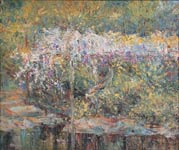 Jitr was born in Bangkok in 1911. He studied at the teacher training course at Rongrian Poh-Chang, and after more than a decade of teaching experience went to Japan on a Thai education ministry a scholarship. In Japan, he studied oil painting and sculpture at Tokyo Fine Arts School. It is often noted as historical fact that he studied oil painting under Kunzo Minami and sculpture under Fumio Asakura, but Jitr himself professes that he did not study under any one specific master.
Jitr was born in Bangkok in 1911. He studied at the teacher training course at Rongrian Poh-Chang, and after more than a decade of teaching experience went to Japan on a Thai education ministry a scholarship. In Japan, he studied oil painting and sculpture at Tokyo Fine Arts School. It is often noted as historical fact that he studied oil painting under Kunzo Minami and sculpture under Fumio Asakura, but Jitr himself professes that he did not study under any one specific master.
As one of the few foreign students to come to Japan from Southeast Asia, Jitr was invited to events held throughout the country, such as the opening ceremony of the Kanmon undersea locomotive tunnel. He painted gorgeous scenes of Japan, rich with seasonal beauty, using his travels as inspiration. In 1942, Jitr held a solo exhibition at the Nichido Gallery and planned an exhibition in his home country as well. But tragically, most of his works, which would have served as important artifacts in the history of Thai-Japanese relations, were burned in bombing raids, and Jitr was only able to bring a few small pieces back to Thailand. Still, it is possible to glean from his remaining body of work that he had mastered portrayal of external light in the impressionist style as seen in his brilliant paintings of Japan’s vistas. Impressionism was not yet known in Thailand at the time, and Jitr is credited as the painter that brought the impressionist style to his homeland.
Jitr’s Artistic Contributions and Japan
Jitr returned to Thailand in 1946 to find the Poh-Chang school building destroyed in a bomb attack. He worked to rebuild the school and served as its headmaster. Jitr modeled the school after the Tokyo Fine Arts School where he himself had studied. He was impressed by Japan’s teaching methods, which struck a balance between Western influence and Japanese tradition, and used them to structure the school’s curriculum. He added new courses, including anatomy, composition, color theory, and art history.
Outdoor nature sketching also came into practice under his leadership. Moreover, Jitr designed the school building by himself — it was erected in Japanese-style mix of Japanese and Western convention known as the “Imperial Crown style,” only with a twist: he added a Thai-style roof to a Western structure.
Jitr’s art studies in Japan were in line with the Thai government’s goal of establishing an art system, and took place within the framework of public art administration and the training of art teachers. But Jitr the painter brought the impressionist style that took root in Japan after the establishment of the Hakubakai in 1895 which was the first Western style painters’ group in Tokyo, and from the mid-1940s to the early 1950s, Jitr provided the opportunity for French impressionism, imported via Japan, to take the Thai art scene by storm. In the late 1950s, Fua Hariphitak’s cubism made an impact among Thai painters, quickly pushing impressionism into the annals of history, but Jitr’s role in the history of Thai-Japanese art exchange will not be forgotten.
Postwar Exchanges: From Prints to Modern Art
On Jitr’s heels came many postwar artists who went to Japan to study, mainly printmakers. This group returned home after learning Japan’s advanced woodblock techniques and played a key role in the development of printmaking in Thailand. The pioneer artist who studied abroad was woodblock printmaker Praphan Srisouta. Srisouta was more interested in Japanese traditions, not in the latest printmaking techniques. Born in Lamphun in the Northern region of Thailand, he went to Japan in 1964 after studying at Silpakorn University. He reportedly spent most of his time studying Ukiyo-e woodblock prints by famed masters such as Hiroshige.
He journeyed from Japan to Germany before returning home in 1967 and went on to gain notoriety for his first solo show,
which showcased 90 of his original woodblock prints. These prints, which were dually influenced by Thai temple mural paintings and Ukiyo-e, portray the daily lives of children and feature vibrant depictions of people and beautiful black and white contrasts, and are considered some of the most precious masterpieces in all of Southeast Asia.
In recent years, Thailand’s modern art has received increased exposure in Japan, ushering in a new era of art exchanges between the two countries. Notable among these artists is Montien Boonma, who is often exhibited in Japan. His installations, which reflect an almost meditative Buddhist mindset, have remained popular even after his sudden death.
One artist of the younger generation has set in motion yet another new turning point in Thai-Japanese art exchange. That artist is Navin Rawanchaikul, who is married to a Japanese woman and works out of Fukuoka, Japan and Chiang Mai. Navin is not content to simply work out of this regional Japanese city. He closely examines the Fukuoka community where he lives and creates pieces that deal with issues within it.
These works have in turn allowed him to become involved in the Fukuoka community. He will continue to be watched as a new harbinger of Thai-Japanese interchange whether from the perspective of a teacher, learning as a foreign student, or showcasing his art.
Remembering the Railway of Death
About a week ago the New York Times had an article entitled “Seeking Recognition for a War’s Lost Laborers” on the lack of recognition for the Asian victims of Japanese forced labor in the construction of the famous “Railway of Death.” According to the article, the history of the 200,000-300,000 Asians who were employed, and often killed, in the construction of the railway, which was being constructed to link Bangkok and the Burmese (Myanmarese) capital of Rangoon (Yangon) to provide logistical support for Japan’s invasion of Southeast Asia, has been almost completely overshadowed by stories of the smaller number of Western POWs.
Between 200,000 and 300,000 Asian laborers — no one knows the exact number — were press-ganged by the Japanese and their surrogates to work on the rail line: Tamils, Chinese and Malays from colonial Malaya; Burmans and other ethnic groups from what is now Myanmar; and Javanese from what is now Indonesia.
“It is almost forgotten history,” said Sasidaran Sellappah, a retired plantation manager in Malaysia whose father was among 120 Tamil workers from a rubber estate forced to work on the railway. Only 47 survived.
[…]
By contrast, the travails of the 61,806 British, Australian, Dutch and American prisoners of war who worked on the railway, about 20 percent of whom died from starvation, disease and execution, have been recorded in at least a dozen memoirs, documented in the official histories of the governments involved and romanticized in the fictionalized “Bridge on the River Kwai,” the 1957 Hollywood classic inspired by a similarly named best-selling novel by Pierre Boulle.
One reason given for this inequality of historical memory are that virtually none of the Asian victims were from Thailand, giving the local government little incentive to commemorate them. Another is that, unlike the American and British POWs who wrote memoirs and gave countless interviews to journalists and historians, virtually none of the Asian laborers were literate, and they lacked ready access to mass media.
At this point, I would like to present some photos I took at a very peculiar museum that Adam, his (now) wife Shoko, and I visited when we were in Kanchanaburi, the location of the famous Bridge on the River Kwai.
The Jeath War Museum (JEATH is an acronym for Japan, English, American and THai) is a rather eccentric museum based on the collection of a wealthy Japanese history buff, who apparently purchased a building a number of years ago, stocked it haphazardly with local WW2 memorabilia of both great and small interest, and has not had arranged to have it cleaned since.
First, some photos from outside the museum itself.
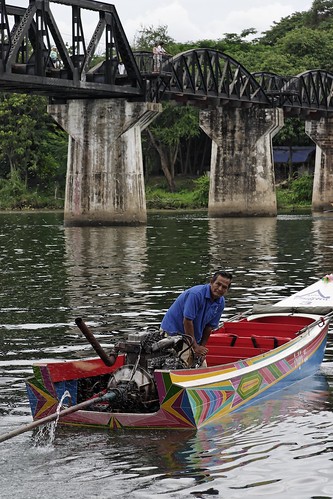
This is a picture of the famous Bridge which I quite like.

Here are Adam and Shoko posing with the bridge behind them. I do not know the sleeping man, but I have to assume that he is a war criminal of some kind.
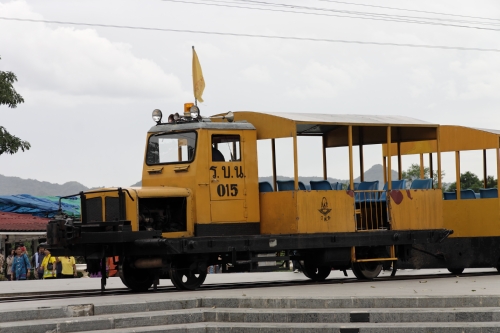
This is a silly little train which lets tourists ride across the bridge and 1 or 2km into the jungle on the other side, and then ride backwards to the other side.

I blurrily snapped this memorial obelisk in the jungle across the river, from aforementioned silly train. It says something along the lines of “the remains of the Chinese army ascend into heaven.”

This plaque is location near the bridge. I did not, however, see one for the British POWs, although I certainly could have just missed it.
And now we reach the museum portion of our tour. I do not seem to have any photographs of the entrance area, but the first thing you see upon approaching the entrance to the museum proper are these statues of historical figures, with biography written on the wall behind them. I will transcribe the highly amusing text another time.

Here is Tojo.
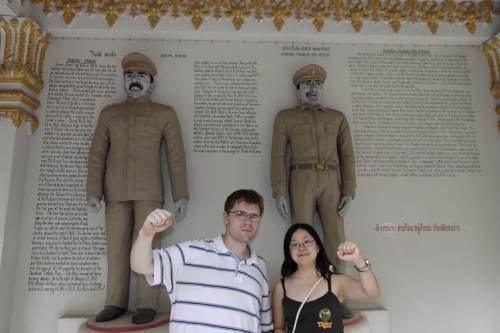
Adam and Shoko again, with their good friends Josef Stalin and General Douglas MacArthur.

The lovable Albert Einstein gets a wall as well.

Inside the museum we are confronted with more dramatic statues, such as this tableau of POWs constructing the railway.
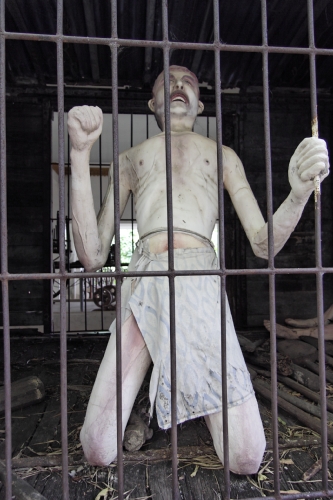
Here is one in a cage. Note the real straw.
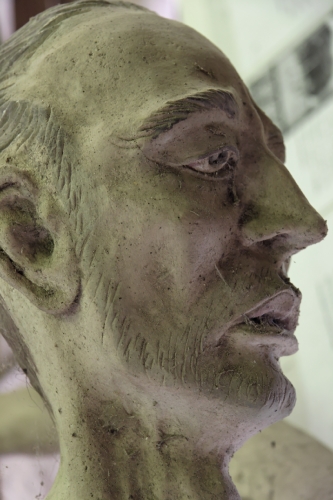
Eerie closeup of another caged POW statue’s face.

Adam and his new friend, the WW2-era Japanese soldier driving an old car.
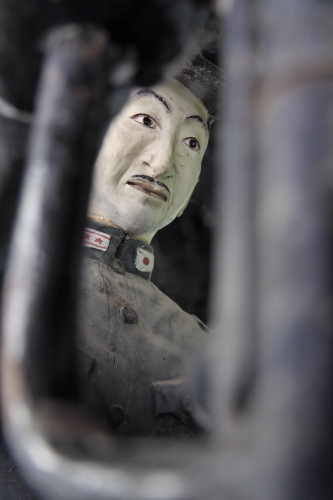
The driver.

Another old car. I do not recognize the make, but it is covered in dust that may weigh as much as the steel.

US Army signal core teletypewriter
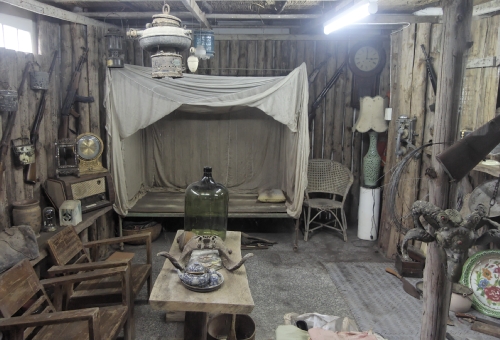
Recreation of Japanese army tent

Read the text carefully. Do you know when the CD was invented?
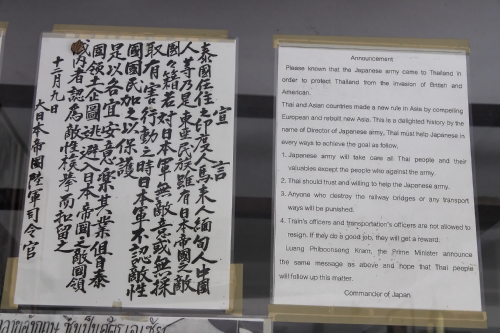
A message from Japan to the Thai people. It’s a bit hard to read, so if anyone wants I can transcribe it.

A British anti-Japan political cartoon
Overall, the museum is a complete shambles. While it has a huge array of cool stuff, it is strewn about almost at random, covered in dust, and sometimes behind other stuff. Not to mention placed in crowded and un-lit cases with poor labeling. Despite the numerous flaws, it is certainly worth a visit if you are in the area, but I can’t say that it will do much to provide any sort of historical narrative, and certainly does not even try to meet the standard hoped for by the Times article I began this post with.
